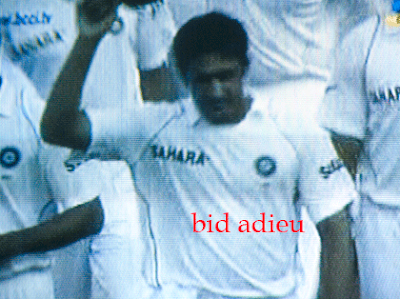
Based on the story by famous Hindi writer, Premchand, Godaan had Raj Kumar playing the character of Hori and Kamini Kaushal as Dhaniya, his wife. The film had music by Pt. Ravi Shankar, who has scored music for only two hindi feature films. The other one, Gulzar’s Meera

One of the first films that started the perinneal trend of shooting films in Kashmir. Nanda the city bred damsel falls for the simple Kashmiri ‘house boat wala’ Shashi Kapoor, who sings for her “Ek tha gul aur ek thee bul bul…. and separately they sing, “Pardesion se na akhian milana….. They also sing a duet, “Na na karte pyaar thumhee se kar baithe……Kalyan ji Anand ji scored the music assisted by Laxmikant Pyarelal !!
 First colour film from the RK Camp had the locales of Europe captured beautifully. The songs, “Bol Radha Bol Sangam Hoga ke Nahin…. “Main ka karun Ram, mujhe buddha mil gayaa…. are still as fresh as they were, almost half a century ago.
First colour film from the RK Camp had the locales of Europe captured beautifully. The songs, “Bol Radha Bol Sangam Hoga ke Nahin…. “Main ka karun Ram, mujhe buddha mil gayaa…. are still as fresh as they were, almost half a century ago.
 It comes as a surprise to many that the Mangeshkar Sisters are actually not three but four in number. Meena Mangeshkar, somehow, never came to lime light ???
It comes as a surprise to many that the Mangeshkar Sisters are actually not three but four in number. Meena Mangeshkar, somehow, never came to lime light ???
 Ranjan, the swashbuckling hero of the south did not make much of an impact on the hindi screen, though he acted with Naseem bano, Madhubala,Meena kumari and others.The first song that comes to my mind is one of my favorite ‘Roop Tumhara aankhon se pee lu’ from the film ‘Sapera’.
Ranjan, the swashbuckling hero of the south did not make much of an impact on the hindi screen, though he acted with Naseem bano, Madhubala,Meena kumari and others.The first song that comes to my mind is one of my favorite ‘Roop Tumhara aankhon se pee lu’ from the film ‘Sapera’.
Jadoo had Nalini Jaywant as his heroine.

They look like the Three Musketeers. But they are (from L to R) Van Shipley (the famous guitarist), Talat Mehmood (needs no introduction) and Enoch Daniels (the famous accordianist).
 Set in the background of mid-19th century Benaras, the film dealt with the clash of two groups of ‘Thugs’. Directed by H.S Rawail, the film had powerful performances by Dilip Kumar, Jayant, Balraj Sahani, Sanjeev Kumar, Vayjanti Mala, Sapru and Ulhas
Set in the background of mid-19th century Benaras, the film dealt with the clash of two groups of ‘Thugs’. Directed by H.S Rawail, the film had powerful performances by Dilip Kumar, Jayant, Balraj Sahani, Sanjeev Kumar, Vayjanti Mala, Sapru and Ulhas
 The RK banner movie was shot and directed by Radhu Karmakar (Raj Kapoor’s favourite cinematographer) on the locales of difficult terrains of Chambal. And with the help of his favourite music directors Shankar Jai Kishan, Jis Desh Mein…. turned out to be a classic. It is said that the movie was instrumental in the surrender of many dacoits of Chambal. Simpleton ‘Raju’ singing “Hothon pe sachhai rehti hai, jahan dil mein safai rehti hai…… ,and Padmini’s O Basanti Pawan Paagal…… and Pran countering with, “Hai aag hamare seenay mein….. are still unparalleled. Not to forget the climax song, Aa ab laut chalein…
The RK banner movie was shot and directed by Radhu Karmakar (Raj Kapoor’s favourite cinematographer) on the locales of difficult terrains of Chambal. And with the help of his favourite music directors Shankar Jai Kishan, Jis Desh Mein…. turned out to be a classic. It is said that the movie was instrumental in the surrender of many dacoits of Chambal. Simpleton ‘Raju’ singing “Hothon pe sachhai rehti hai, jahan dil mein safai rehti hai…… ,and Padmini’s O Basanti Pawan Paagal…… and Pran countering with, “Hai aag hamare seenay mein….. are still unparalleled. Not to forget the climax song, Aa ab laut chalein…
 None of his colleges at the Remington Typewriters could have ever imagined that the sales man who sold typewriters in Calcutta would become a legendary star singer in the Hindi Film Industry. Discovered by R.C Boral of New Theaters, Saigal rose to such heights that even today, the name K.L. Saigal conjures up images of the great Indian singing film star of the 1930s and 1940s with the unmatched golden voice.
None of his colleges at the Remington Typewriters could have ever imagined that the sales man who sold typewriters in Calcutta would become a legendary star singer in the Hindi Film Industry. Discovered by R.C Boral of New Theaters, Saigal rose to such heights that even today, the name K.L. Saigal conjures up images of the great Indian singing film star of the 1930s and 1940s with the unmatched golden voice.
 Shahrukh Khan may have claimed after Bazigar that he dared to do a negative character. Dev Anand did that with aplomb, long ago when Shahruk was not even born. This film written and directed by Guru Dutt had flamboyant Geeta Bali playing the lead opposite Dev Anand who mellowed her down by singing “Yeh raat yeh chaandni phir kahan…. tuned by S.D Burman
Shahrukh Khan may have claimed after Bazigar that he dared to do a negative character. Dev Anand did that with aplomb, long ago when Shahruk was not even born. This film written and directed by Guru Dutt had flamboyant Geeta Bali playing the lead opposite Dev Anand who mellowed her down by singing “Yeh raat yeh chaandni phir kahan…. tuned by S.D Burman
 This Sridhar directed love triangle Rajendra Kumar as a doctor and Raj Kumar as the patient and Meena Kumari, torn between the two. “Yaad na jaaye, beete dinon ki… Yahaan koi nahin, tera mere siwa…. Hum tere pyaar mein saara aalam kho baithe…. were nicely tuned by Shankar Jaikishan. And of course the title song, Dil ek mandir hai…
This Sridhar directed love triangle Rajendra Kumar as a doctor and Raj Kumar as the patient and Meena Kumari, torn between the two. “Yaad na jaaye, beete dinon ki… Yahaan koi nahin, tera mere siwa…. Hum tere pyaar mein saara aalam kho baithe…. were nicely tuned by Shankar Jaikishan. And of course the title song, Dil ek mandir hai…
 Shammi Kapoor in his first directorial venture brought Irma La Douce to India. The ‘bindass’ prostitute Zeenat Amaan and the ‘simpleton’ police constable Sanjeev Kumar gave the perfect ‘entertainment’ to the public. The 1974 film is considered to be much, much, much, ahead of it’s time. R.D. Burman provided some befitting tunes to the ‘manoranjan’ of the audience.
Shammi Kapoor in his first directorial venture brought Irma La Douce to India. The ‘bindass’ prostitute Zeenat Amaan and the ‘simpleton’ police constable Sanjeev Kumar gave the perfect ‘entertainment’ to the public. The 1974 film is considered to be much, much, much, ahead of it’s time. R.D. Burman provided some befitting tunes to the ‘manoranjan’ of the audience.
 A favourite of B.R. Chopra and music director, Ravi. Mahendra Kapoor won his first film fare award for “Chalo ek baar phir se, ajnabee ban jaayen hum dono”. Patriotic songs were his forte. The voice of ‘Mr. Bharat’, he rendered, “Mere Desh ki Dharti…..” Hai Preet Jahan ki Reet Sadaa…..” “Ektara Bole…..” and made the Indians feel proud of being Indian ! He passed away recently on 28th September.
A favourite of B.R. Chopra and music director, Ravi. Mahendra Kapoor won his first film fare award for “Chalo ek baar phir se, ajnabee ban jaayen hum dono”. Patriotic songs were his forte. The voice of ‘Mr. Bharat’, he rendered, “Mere Desh ki Dharti…..” Hai Preet Jahan ki Reet Sadaa…..” “Ektara Bole…..” and made the Indians feel proud of being Indian ! He passed away recently on 28th September.
 This, Pradeep Kumar as ‘Salim’ and Bina Rai as Anarkali’ starrer film had some melodious songs by C. Ramchandra. Mubarak played the role of Akbar.
This, Pradeep Kumar as ‘Salim’ and Bina Rai as Anarkali’ starrer film had some melodious songs by C. Ramchandra. Mubarak played the role of Akbar.
 The film was planned to be made in B&W. V. Shantaram had injured his eyesight during the fight sequence with a bullock in his earlier film, “Do Aankhen Barah Haath”. When he regained his eye sight, he realised the importance of colours in life. He then made NAVRANG in colour. Shantaram has expressed the reason of making the film in colour in his brief but telling address at the beginning of the film itself. Shantaram lends credence to the rumours that he nearly lost his sight in an accident on the sets of his last venture, Do Aankhen Barah Haath. An eternal optimist, Shantaram reveals that during that temporary blindness, he saw some hitherto unseen colours of life.Critics trashed the kitschy and convoluted tale but the audience loved it. Dances by Sandhya and the music by Vasant Desai were superlative ! Indeed, NAVRANG is A RIOT OF COLOURS !!
The film was planned to be made in B&W. V. Shantaram had injured his eyesight during the fight sequence with a bullock in his earlier film, “Do Aankhen Barah Haath”. When he regained his eye sight, he realised the importance of colours in life. He then made NAVRANG in colour. Shantaram has expressed the reason of making the film in colour in his brief but telling address at the beginning of the film itself. Shantaram lends credence to the rumours that he nearly lost his sight in an accident on the sets of his last venture, Do Aankhen Barah Haath. An eternal optimist, Shantaram reveals that during that temporary blindness, he saw some hitherto unseen colours of life.Critics trashed the kitschy and convoluted tale but the audience loved it. Dances by Sandhya and the music by Vasant Desai were superlative ! Indeed, NAVRANG is A RIOT OF COLOURS !!
 “C” stood for “Chitalkar” in C. Ramachandra. As a music director his name used to appear on the covers as C. Ramchandra. As a singer it used to be Chitalkar. For a long time the public considered the names to be of two different people !
“C” stood for “Chitalkar” in C. Ramachandra. As a music director his name used to appear on the covers as C. Ramchandra. As a singer it used to be Chitalkar. For a long time the public considered the names to be of two different people !
“Ina, Mina, Dika……” Shola Jo Bhadke…..” Kitna Haseen Hai Mausam….” Aana Meri Jaan Meri Jaan Sunday ke Sunday….” That’s C. Ramachandra. His biggest success was Anarkali. “Muhobbat Aisi Dhadkan Hai….”, “Yeh Zindagi Usi ki Hai…..”, “Jaag Dard-e Ishq Jaag…..” became huges hits and were highly acclaimed as masterpieces. After the China war in 1962, C. Ramchandra composed a song written by Kavi Pradeep and sung by Lata Mangeshkar, which was to become history – “Aey Mere Watan Ke Logo……” After hearing this song, Nehru had tears in his eyes and he said to Lata, “tumne to hamein rula diya…..”
 This 1966 film, a remake of Tamil film, Kaadalikka Neramillai, was as straight as a ‘jalebi’ ! Sridhar who had made tear jerkers like Dil Ek Mandir, made audience laugh to tears this time ! Om Prakash, Kishore Kumar and Mehmood made audience fall off their seats. Laxmikant Pyare Lal scored some hummable songs. But it was Rajinder Krishan’s witty dialogues that was the life of the film.
This 1966 film, a remake of Tamil film, Kaadalikka Neramillai, was as straight as a ‘jalebi’ ! Sridhar who had made tear jerkers like Dil Ek Mandir, made audience laugh to tears this time ! Om Prakash, Kishore Kumar and Mehmood made audience fall off their seats. Laxmikant Pyare Lal scored some hummable songs. But it was Rajinder Krishan’s witty dialogues that was the life of the film.
 Raj Kapoor was once asked as to which of his films was closest to his heart ? He replied that for a Father all his children were equal but the Father gives extra care and affection to the child who is, unfortunately, handicapped…….
Raj Kapoor was once asked as to which of his films was closest to his heart ? He replied that for a Father all his children were equal but the Father gives extra care and affection to the child who is, unfortunately, handicapped…….
 This, mother (sorry, it should be Father) of all the double role films, to come was the Hindi adaptation of the Telegu film “Ramudu Bheemudu” directed by Chanakya for producers B. Nagi Reddy. The original theme of these movies was derived from Alexandre Dumas’ story “The Corsican Brothers”. The story charts the growth of two twin brothers who having separated at a very early age of their lives develop absolutely contrasting temperaments. The mix up between the brothers causes a many hilarious situations. Naushad rendered some beautiful musical score for the film.
This, mother (sorry, it should be Father) of all the double role films, to come was the Hindi adaptation of the Telegu film “Ramudu Bheemudu” directed by Chanakya for producers B. Nagi Reddy. The original theme of these movies was derived from Alexandre Dumas’ story “The Corsican Brothers”. The story charts the growth of two twin brothers who having separated at a very early age of their lives develop absolutely contrasting temperaments. The mix up between the brothers causes a many hilarious situations. Naushad rendered some beautiful musical score for the film.
 When Meena Kumari married Kamal Amrohi at the peak of her career she wrote this about him
When Meena Kumari married Kamal Amrohi at the peak of her career she wrote this about him
“Dil saa jab saathi paya
Bechaini bhi woh saath le aaya”
“Tum kya karoge sunkar mujhse meri kahani
Belutf zindagi ke kisse hain pheeke pheeke”
When he divorced her, this is what she wrote,
“Talaak to de rahe ho Nazare kahar ke saath
Jawani bhi mere lauta do Mehar ke saath”
She had fervently wanted to release an album of her poetry sung by herself which was ultimately achieved, with Khyaam providing the music to her ‘Shairi’.
 This one is an odd man (and women) out, in the whole lot. But Yash Chopra still made a vinyl record from the original soundtrack of the film in the times of CDs and DVDs !
This one is an odd man (and women) out, in the whole lot. But Yash Chopra still made a vinyl record from the original soundtrack of the film in the times of CDs and DVDs !
When Sholay was released on 15th August 1975, it was written off as a flop by almost every critic and trade magazines. “A great and costly mistake” – Filmfare, Film Trade Magazine, India Today and many more had the same opinion about ‘Sholay’. K.M. Amladi wrote in the India Today – ‘dead ember’, thematically, its a gravely flawed attempt’. Bikram Singh wrote in the Filmfare – ‘The major trouble with the film is the unsuccessful transplantation it attempts in grafting a western on the Indian milieu”. The Film Information said, “The classes and families will find no reason for a repeat show”. Not only the most knowledgeable of the critics but the black marketeers too had written off the film. Inspite of all said, Sholay picked up business in it’s fifth week and then went on to create history – the first film in the history of Indian Cinema to have celebrated silver jubilee in more than hundred cinemas across the country ! In spite of a thundering success of the film, the music records of the film did not sell to the expectations of the recording company, Polydor. The reason for that was that the strong dialogues of the film overpowered the music. On realising this, Polydor, released a double album of dialogues of the film that had just a line or two of the songs. The tactics paid off and there was a huge sale of records all over again ! Nevertheless, the songs, “Koi Haseena Jab Rooth Jaati Hai To……” Holi Ke Din…..” Yeh Dosti……” and, of course, “Mehbooba Mehbooba……” too became popular, though much later. Believe this too – Shoaly bagged only one Filmfare award and that too for Best Editing (M.S Shinde). However, at the 50th year of Filmfare Awards, Sholay received the ‘Best Film of 50 Years’ award !!
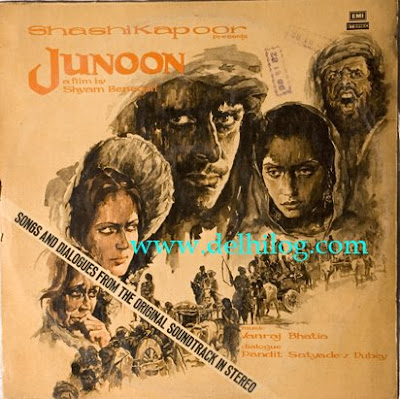 ‘A flight of Pigeons’. The story by Ruskin Bond was transformed into Junoon by Shyam Benegal. Produced by Shashi Kapoor, the film was set against the backdrop of unrest of 1857 in the country. Shashi Kapoor, Shabana Azmi, Jennifer (Kendal) Kapoor, Naseeruddin Shah starred in the film. Nafisa Ali (then a national swimming champion) was introduced in this film. Vanraj Bhatia scored the music for the film. “Ishq Ne Todi, Sar Pe Qayamat…” sung by Mohd. Rafi and “Ghir Aayee Kaari Ghata Matwaari……” sung by Preeti Sagar became popular hits. “Khusro Rain Piya Ki Jaagi Pee Ke Sang….” a qawwali sung by Jamil Ahmad was also a highlight of the film. Made in 1978, Junoon went on to bag the National Awards for the Best Film, Best Cinematography (Govind Nihalani) and Best Audiography (Hitendra Ghosh) in 1979. A year later it captured eight Filmfare Awards for Best Film, Best Director, Best Cinematography, Best Sound Recording (audiography) Best Dialogues (Pandit Satyadev Dubey), Best Editing (Bhanudas Diwakar), Best Supporting Actor (Naseerudin Shah) and Best Supporting Actress (Jennifer Kendal Kapoor)
‘A flight of Pigeons’. The story by Ruskin Bond was transformed into Junoon by Shyam Benegal. Produced by Shashi Kapoor, the film was set against the backdrop of unrest of 1857 in the country. Shashi Kapoor, Shabana Azmi, Jennifer (Kendal) Kapoor, Naseeruddin Shah starred in the film. Nafisa Ali (then a national swimming champion) was introduced in this film. Vanraj Bhatia scored the music for the film. “Ishq Ne Todi, Sar Pe Qayamat…” sung by Mohd. Rafi and “Ghir Aayee Kaari Ghata Matwaari……” sung by Preeti Sagar became popular hits. “Khusro Rain Piya Ki Jaagi Pee Ke Sang….” a qawwali sung by Jamil Ahmad was also a highlight of the film. Made in 1978, Junoon went on to bag the National Awards for the Best Film, Best Cinematography (Govind Nihalani) and Best Audiography (Hitendra Ghosh) in 1979. A year later it captured eight Filmfare Awards for Best Film, Best Director, Best Cinematography, Best Sound Recording (audiography) Best Dialogues (Pandit Satyadev Dubey), Best Editing (Bhanudas Diwakar), Best Supporting Actor (Naseerudin Shah) and Best Supporting Actress (Jennifer Kendal Kapoor)
 The second directorial venture (after Dhool Ka Phool) of Yash Chopra, Waqt pioneered the ‘lost and found’ trend in the Bollywood. An ensemble caste of actors (Balraj Sahni, Raj Kumar, Sunil Dutt, Shashi Kapur, Sadhna, Sharmila Tagore and Rehman) had the two most famous songs, composed by Ravi, “Aage Bhi Jaane Na Tu….” and “Aye Meri Zohra Zabeen……”, apart from the two dialogues, which are still popular today after almost half a century. “Chinoy Seth, jinke apne ghar sheeshe ke hon, woh doosron par patthar nahin phenka karte !” and “Ye bachhon ke khelne ki cheez nahin, haath kat jaaye, to khoon nikal aata hai !” spoken by Raj Kumar in his indomitable style. All of this and the court room arguements between Sunil Dutt and Moti Lal, in the climax, makes the film all-time-popular.
The second directorial venture (after Dhool Ka Phool) of Yash Chopra, Waqt pioneered the ‘lost and found’ trend in the Bollywood. An ensemble caste of actors (Balraj Sahni, Raj Kumar, Sunil Dutt, Shashi Kapur, Sadhna, Sharmila Tagore and Rehman) had the two most famous songs, composed by Ravi, “Aage Bhi Jaane Na Tu….” and “Aye Meri Zohra Zabeen……”, apart from the two dialogues, which are still popular today after almost half a century. “Chinoy Seth, jinke apne ghar sheeshe ke hon, woh doosron par patthar nahin phenka karte !” and “Ye bachhon ke khelne ki cheez nahin, haath kat jaaye, to khoon nikal aata hai !” spoken by Raj Kumar in his indomitable style. All of this and the court room arguements between Sunil Dutt and Moti Lal, in the climax, makes the film all-time-popular.
 Produced by Tarachand Barjatya for Rajshri Films (famous for making clean films), Dosti was directed by Satyen Bose. The debut film of Sanjay Khan, (though in a small role) revolved around two friends played by Sudhir Kumar and Sushil Kumar in the lead. The songs “Chhahoonga Main Tujhe, Saanjh Savere…..”, Mera To Jo Bhi Kadam Hai, Woh Teri Raah Mein Hai…..”, “Raahi Manwa Dukh Ki Chinta Kyon Satati Hai…..”, “Jaane Waalo Zaraa Mud ke Dekho Mujhe…..” and “Teri Dosti Mera Pyaar…..” became superhits. The film won the Best Film award at the Filmfare Awards and so did the music directors Laxmikant and Pyarelal, Mohd. Rafi for singing, “Chahoonga Main Tujhe…..” and Majrooh Sultanpuri for penning that song. Schools made bulk bookings at the theaters to take students for the show.
Produced by Tarachand Barjatya for Rajshri Films (famous for making clean films), Dosti was directed by Satyen Bose. The debut film of Sanjay Khan, (though in a small role) revolved around two friends played by Sudhir Kumar and Sushil Kumar in the lead. The songs “Chhahoonga Main Tujhe, Saanjh Savere…..”, Mera To Jo Bhi Kadam Hai, Woh Teri Raah Mein Hai…..”, “Raahi Manwa Dukh Ki Chinta Kyon Satati Hai…..”, “Jaane Waalo Zaraa Mud ke Dekho Mujhe…..” and “Teri Dosti Mera Pyaar…..” became superhits. The film won the Best Film award at the Filmfare Awards and so did the music directors Laxmikant and Pyarelal, Mohd. Rafi for singing, “Chahoonga Main Tujhe…..” and Majrooh Sultanpuri for penning that song. Schools made bulk bookings at the theaters to take students for the show.
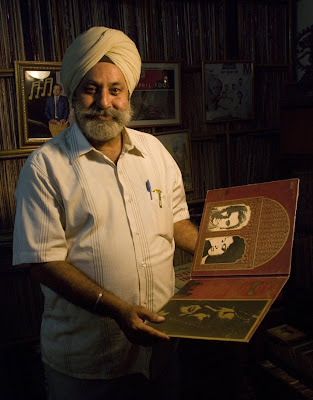 This post may look like a sequel to one of my earlier posts “For Records’ Sake”. But in all earnest, it is not. Mr. Lakhwant Singh an engineer by profession and in the business of building bodies for buses, saw the post that I had done for Shah Music Centre. He called me up one day and asked if I could come over to his place as he had something similar to show to me, that I had done for the Shahs. Like the Shahs, Lakhwant Singh too is a collector of vinyl records of the yesteryears. But the similarity ends there. Unlike Shahs – who have been into collecting records for three generations and are into the business in a hardcore way – Lakhwant Singh does it purely for the passion and pleasure of it. It all started during his hostel days at Pant University,where he was pursuing a degree in engineering. He bought his first 78 rpm record of ‘Udan Khatola’ to listen to the song ‘Na Toofan Se Khelo Na Saahil Se Khelo, Mere Paas Aao Mere Dil Se Khelo’. He shelled out two-and-a-half rupees for it solely for the listening pleasure. Hardly did he imagine at that time that collecting records would become a passion for him. While other fellow students were collecting stamps and coins as a hobby, Lakhwant gradually developed the hobby of collecting records. Today, after five decades, Lakhwant has almost all the hindi film and non film records released so far. Apart from Hindi numbers, Lakhwant has a huge collection of old Punjabi records too.
This post may look like a sequel to one of my earlier posts “For Records’ Sake”. But in all earnest, it is not. Mr. Lakhwant Singh an engineer by profession and in the business of building bodies for buses, saw the post that I had done for Shah Music Centre. He called me up one day and asked if I could come over to his place as he had something similar to show to me, that I had done for the Shahs. Like the Shahs, Lakhwant Singh too is a collector of vinyl records of the yesteryears. But the similarity ends there. Unlike Shahs – who have been into collecting records for three generations and are into the business in a hardcore way – Lakhwant Singh does it purely for the passion and pleasure of it. It all started during his hostel days at Pant University,where he was pursuing a degree in engineering. He bought his first 78 rpm record of ‘Udan Khatola’ to listen to the song ‘Na Toofan Se Khelo Na Saahil Se Khelo, Mere Paas Aao Mere Dil Se Khelo’. He shelled out two-and-a-half rupees for it solely for the listening pleasure. Hardly did he imagine at that time that collecting records would become a passion for him. While other fellow students were collecting stamps and coins as a hobby, Lakhwant gradually developed the hobby of collecting records. Today, after five decades, Lakhwant has almost all the hindi film and non film records released so far. Apart from Hindi numbers, Lakhwant has a huge collection of old Punjabi records too. misunderstanding; while digital media is undeniably more convenient than its analog equivalent,it is by no mans guaranteed to be superior. And there’s no better example of this than the vinyl record. This ‘dead’ technology offers the potential for sound quality that’s far superior to what one hears from
misunderstanding; while digital media is undeniably more convenient than its analog equivalent,it is by no mans guaranteed to be superior. And there’s no better example of this than the vinyl record. This ‘dead’ technology offers the potential for sound quality that’s far superior to what one hears from  a CD or MP3 players, so much so that the joys of vinyl are being redicovered by a new generation of music fans. Had this not been the case, Yash Chopra, in this era of digital sound, would not have come out with the vinyl version of the music of two of his great works, ‘Dil to Pagal Hai’ and ‘Veer Zaara’.
a CD or MP3 players, so much so that the joys of vinyl are being redicovered by a new generation of music fans. Had this not been the case, Yash Chopra, in this era of digital sound, would not have come out with the vinyl version of the music of two of his great works, ‘Dil to Pagal Hai’ and ‘Veer Zaara’.
 time of the vinyl recording. (Like it was done when Lata Mangeshkar performed live at Albert Hall London in 1974 and Naushad had conducted the orchestra). It retains a retro appeal and a visceral aural aesthetic that an endless stream of bits and bytes will never be able to equal.
time of the vinyl recording. (Like it was done when Lata Mangeshkar performed live at Albert Hall London in 1974 and Naushad had conducted the orchestra). It retains a retro appeal and a visceral aural aesthetic that an endless stream of bits and bytes will never be able to equal. Lakhwant Singh then played that eight minute track which was sung by Kishore Kumar, Bhupender, Manna Dey and Anand Bakshi (the famous song writer who also wrote songs for Sholay). The Qawwali, “Chaand sa Koi Chhehra na Pehloo Mein Ho, To Chaandni ka Mazaa Nahin Aata, Jaam Peekar Sharaabi Na Gir Jaaye to Maikashi Ka Mazaa Nahin Aata”, was picturised at Soorma Bhopali’s shop.
Lakhwant Singh then played that eight minute track which was sung by Kishore Kumar, Bhupender, Manna Dey and Anand Bakshi (the famous song writer who also wrote songs for Sholay). The Qawwali, “Chaand sa Koi Chhehra na Pehloo Mein Ho, To Chaandni ka Mazaa Nahin Aata, Jaam Peekar Sharaabi Na Gir Jaaye to Maikashi Ka Mazaa Nahin Aata”, was picturised at Soorma Bhopali’s shop. his vast library. He proudly displays a rare collection of a set of thirteen LPs of Beatles’ records, which were released in a hard bound pack with the signatures of the Fab Four – John Lenon, Paul McCartney, George Harrison and Ringo Starr (Richard Starkey) – on the pack. It’s a rare piece of collector’s item, nearly impossible to find.
his vast library. He proudly displays a rare collection of a set of thirteen LPs of Beatles’ records, which were released in a hard bound pack with the signatures of the Fab Four – John Lenon, Paul McCartney, George Harrison and Ringo Starr (Richard Starkey) – on the pack. It’s a rare piece of collector’s item, nearly impossible to find.
 particular record of Cliff Richard – CLIFF RICHARD AND THE SHADOWS – a rare red coloured vinyl 12-track Odeon label stereo LP made in Japan, complete with near impossible to find 3/4 length ‘hankake obi strip’ – A stunning addition to any Cliff collection
particular record of Cliff Richard – CLIFF RICHARD AND THE SHADOWS – a rare red coloured vinyl 12-track Odeon label stereo LP made in Japan, complete with near impossible to find 3/4 length ‘hankake obi strip’ – A stunning addition to any Cliff collection





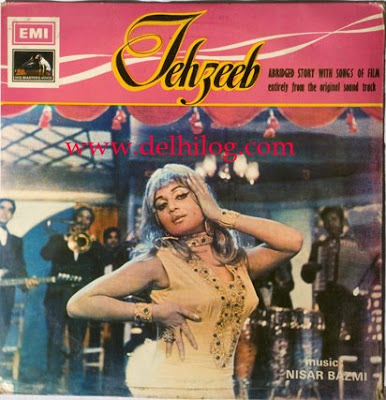
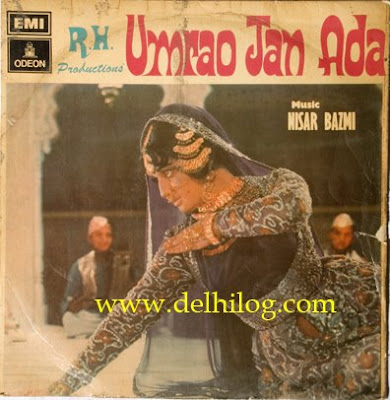
 minor creasing around the perimeter and a very slight ringwear impression on the covers (considering that some records are as old as forty years). The curved flipbacks are secure, there are no seam splits and distinctive pinched-edge spine is strong, with clearly legible print along the length. And to maintain all the collection of records, he is ably assisted by his disciple Gurmeet Singh and nephew Ramanjit Singh
minor creasing around the perimeter and a very slight ringwear impression on the covers (considering that some records are as old as forty years). The curved flipbacks are secure, there are no seam splits and distinctive pinched-edge spine is strong, with clearly legible print along the length. And to maintain all the collection of records, he is ably assisted by his disciple Gurmeet Singh and nephew Ramanjit Singh
































